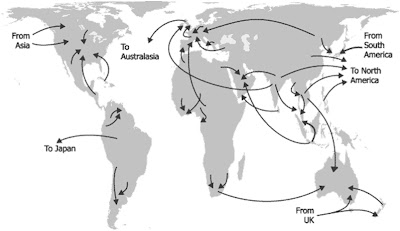Migration theory
Each migrant has different circumstances and motivations for moving. These can be, poverty, adventure and, desperation. People uproot themselves to work in foreign lands with all kinds of hopes and plans.
But there are also common features and patterns, and governments in both countries of origin and destination are keen to understand them. The simplest explanation is that people move to places where they hope to be better off. But this leaves a lot of questions unanswered. Why do the very poorest not migrate? Why do certain nationalities head for certain countries? Attempts to answer such questions have generally taken one of two broad approaches: the individual or the structural.
The individual and the family perspective
The individual approach considers each migrant as a rational human being who assesses the available destinations and chooses the optimum combination - of wage rates, job security, and cost of travel. This is called the 'human capital' approach since each person can be considered as the product of a series of investments - in their education, for example, or their skills, or their health - who is looking for the best place to use them.
An extension of the individual view is to consider migration as a group or family choice, as a means of spreading risk. In this co-insurance system the head of the family will pay the emigrant's travel expenses and living costs while he or she looks for work. The migrant correspondingly promises to send money home, especially if the family suffers a difficulty such as a crop failure. This household theory of migration is sometimes called the 'New Economics of Migration', though by now it is not particularly new
The structural perspective
The structural perspective, on the other hand, sees people's fate determined ultimately by structures - social, economic and political, that shape their lives.
Structural factors such as un employment, or the influence of international media or population pressure, for example, or can be seen as 'pushing' emigrants from their homes and 'pulling' them to their destinations
Why do people migrate?
Wage gaps
Most people migrate, either temporarily or permanently, to take advantage of opportunities in richer countries — to earn more money and widen their horizons.
Another reason why people migrate is that many richer countries have jobs available for immigrant workers.
Development disruption
Another factor influencing emigration is the disruption caused by economic and social development.
How do people migrate?
Colonial Path
France and the United Kingdom initiated many migrant flows by recruiting workers from their former colonies.
The United States, on the other hand, had few formal colonies but nevertheless exerted military and economic influence over a number of developing countries, particularly near neighbors such as Mexico. In the early 1900s Mexicans had little wish to live in the United States. So United States farmers and railroad companies had to send recruiters deep into Mexico. Later, in the 1940s, farm owners made similar efforts to find Mexican workers through the bracero temporary workers scheme — a program that continued up to 1964.
Family Ties
Reinforcing the colonial patterns are family reunification program. Receiving countries give priority to close relatives of existing residents.
The acceptance of family reunification arises at least in part from a greater respect for human rights. The Universal Declaration of Human Rights establishes that everyone has the right to marry and that the family is the 'fundamental unit of society' entitled to protection from the state. But there are also sound social reasons for allowing migrants to be with their families, since workers with families tend to integrate better.
This has had a profound influence on modern patterns of migration. In recent years, family entry has accounted for two-thirds of all immigration into the United States, and for over one-quarter of all immigration into Australia and Canada. Illegal immigrants too want their families to join them.
Smugglers
Migrants who want to enter countries illegally may travel independently but many often use the services of smugglers.
Smugglers act as extra-legal travel agents - hiding people in trucks for example, or supplying false passports, or bribing immigration officials. This is a dangerous, but usually very profitable, business.
Traffickers
People being smuggled are traveling voluntarily. People being trafficked on the other hand have in some way been coerced, taken by force, perhaps, or deceived. According to the US State Department annually at least 800,000, and possibly as many as four million people, worldwide were bought, sold, transported and held against their will in slave-like conditions.
